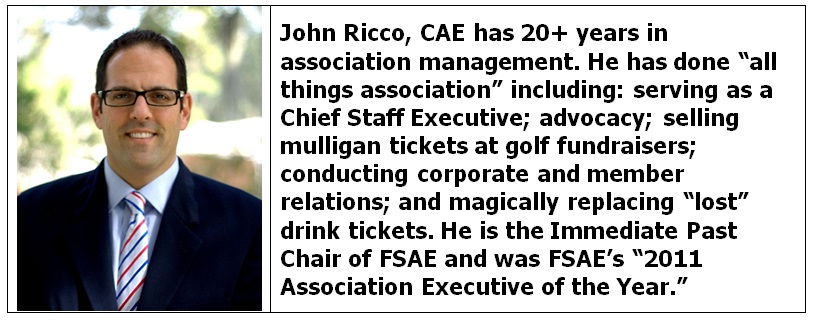By: John Ricco, CAE
Not in a million years did I think that I would find myself connected (even tangentially) to a major event that would grip the nation. This changed with the June 12 Orlando mass shootings. In my role as Executive Director of the Florida Cemetery Cremation and Funeral Association, the FCCFA membership was called upon to aid state and local governments with their process of identification and transportation of the deceased and then later to serve their families by providing funerals and memorials services.
While the tragedy has left many shocked and disheartened, the unfortunate fact remains that there is much work to be done in the aftermath of such an event for local and state officials, physicians, funeral professionals and many others. For those who work in an association whose members might be involved in the wake of a disaster, it is helpful to have a plan to deal with crises such as this. Let’s face it, unless you’re a West Wing character that can spit out witty repartee at 1000 words a minute and solve the world’s policy problems in the time it takes to tie a shoe, you’re probably going to need a plan.
While only on the periphery of events, in the aftermath of the mass shooting, our organization was in communication with the Florida Emergency Mortuary Operation Response System, the Florida Bureau of Vital Statistics, The Florida Chief Financial Officer’s Office, the Florida Division of Funeral, Cemetery and Consumer Services, the Florida Attorney General’s Office, the local medical examiner’s office, multiple local government and law enforcement officials, and members in the region and around the state, to name a few. In addition, communications and offers of assistance were fielded from many national and state associations along with industry partners.
There are many facets to crisis management: prevention, decision making, response, recovery, communications, and more. The following are some tips for your organization’s preparation to assess and prepare, should an event affect your members. Below I’ve detailed six “must have’s” for your association’s crisis plan. You’ll be glad you spent the time to develop them should you need them – I’m glad we had them in ours. If you don’t have a plan, start one – today.
1 – Have a Goal
The goal should be to provide a standardized strategy for addressing situations where events such as natural disasters, man-made crises or news reports by media outlets may be potentially disruptive to your members’ industry/profession. These events could have positive or negative consequences.
2 – Identify Trigger Points
Most situations will be unique. The goal of your plan is to serve as a general structure with core messages that will relate to most situations. It is beneficial to map out what may occur to trigger an event that will affect your organization. Typically, you will be dealing with a natural or man-made disaster, a news story detailing unprofessional or unethical conduct of individuals or companies, or perhaps even a positive story gone viral (think of the ALS Ice Bucket Challenge and media attention it garnered).
Typically, each event has elements of the unknown and has the potential to escalate; has the potential to interrupt normal business operations; may impact the reputation of your organization or its members; or has the potential to impact the industry’s financial performance.
Make sure you identify the “trigger points” so that you can develop checklists, contact information, draft message points, and other materials that may be helpful in a crisis.
3 – Identify a Core Crisis Team (CCT)
Identify your core crisis team. In most instances this group should include your executive committee; key members involved in government relations, public relations, and regulatory affairs; appropriate staff (executives, governmental affairs, communications, and counsel); and key liaisons with national, state and local affiliates. Also, if your organization has members that may have communications, legal or other resources they can bring to bear, consider including them.
Be sure to identify, in advance, who will speak on behalf of the CCT when needed. Depending upon the circumstances that person may vary but determine who may be asked to address the media, community leaders, and your membership.
4 – Define the Role of the Core Crisis Team
The CCT should be charged with assessing the situation at hand, identifying potential causes and remedies, developing strategies for addressing the situation and communicating those actions to the membership, media, and public.
Some of the factors to be evaluated should include:
Timing: How urgent is the event? Is a deadline involved? What will happen if nothing is done?
Trends: Will the problem get worse? Does the event have the potential for growth?
Impact: How serious is the problem? What are the effects on people, products, the environment, and organization?
In advance, the CTT should create mock scenarios of likely problems and outline actions the organization is likely to take. What actions would your organization take to deal with a natural disaster? Man-made disaster? Inappropriate actions of individual members or companies? What actions would your organization take to deal with these situations? For example, what if after a hurricane your organization, the National Association of Hardware Stores, had multiple members in 4 states accused of price gouging?
You cannot capture every scenario, but it is helpful to map out the likely causes and remedies.
5 – Develop Industry Information Points
A comprehensive list of industry facts is helpful to have at your fingertips if needed, including any charitable/philanthropic activities your organization my initiate or participate in.
Basic industry facts may include the size of the profession or industry, number of people served and the economic impact of your members businesses or professions nationally or statewide. In regulated professions you may want to include information on licensing requirements, accreditations needed, continuing education requirements, minimum educational requirements, practical experience requirements, etc.
In short, this section should include anything that can be used to establish the importance, competency and commitment of your members to the profession and community at large.
6 – Identify Additional Partners / Resources
This section should identify any industry partners, related associations, governmental agencies and key contacts you may be need to partner with or rely on for assistance should a crisis strike. Include state, national and sister organizations. As mentioned above, we were in communication with over a dozen entities after the event of June 12. Having a readily accessible “key contacts” list is essential for simplification as well as reminding you of others you may need to be in communication with or who may be able to assist you.
I hope these six tips help you and your organization should you have to deal with a crisis.
Our thoughts and prayers are with the victims and their families. #OneOrlando #OrlandoUnited

Photo of the FEMORS volunteers who aided in post-shooting recovery efforts.





